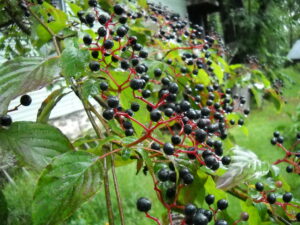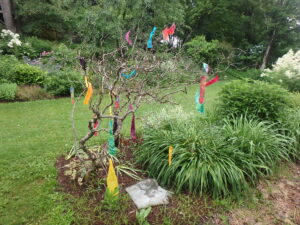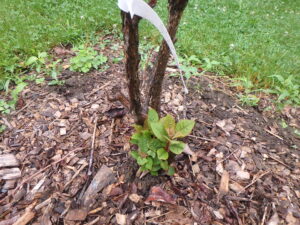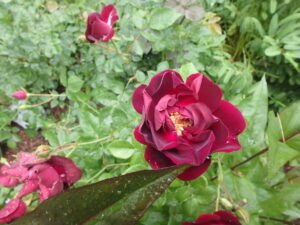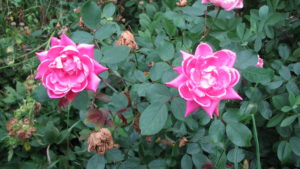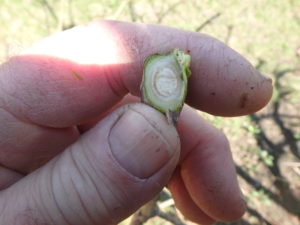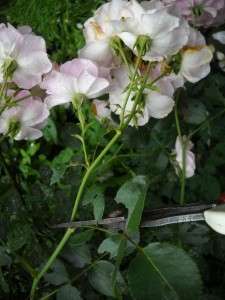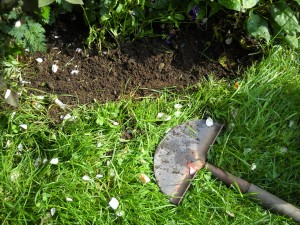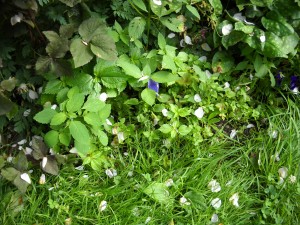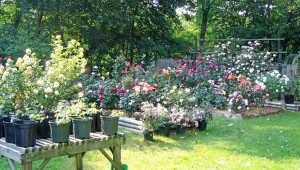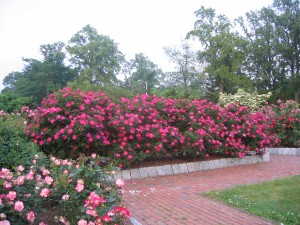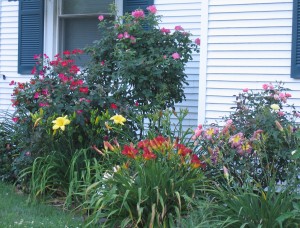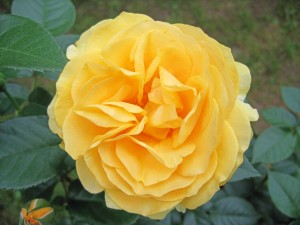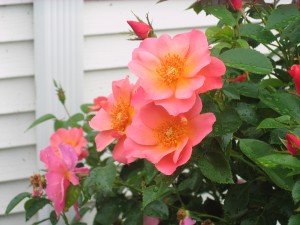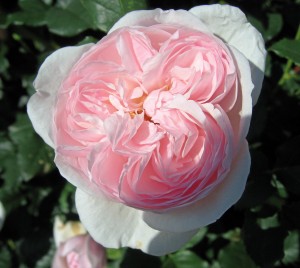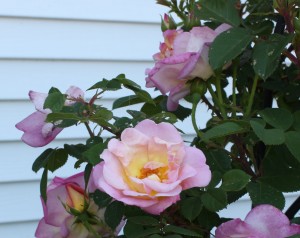What to Do with a Dead Tree?
I have a native dogwood tree that shows up all over my property. It is called the pagoda dogwood ( Cornus alternifolia) and is one of my favorites. This small tree never gets much taller than 10 feet, has just finished blooming with understated white blossoms, and has blue berries loved by birds in July or August.
In the meantime, my wife Cindy and I decorated it with colorful strips of cloth. Each is just a couple of inches wide and perhaps a foot long. She attached threads to the top of each so we could tie them on like Christmas ornaments. Even the slightest breeze has them fluttering and twisting. It’s lovely.
As I was lopping off the branches prior to digging it out, I noticed a few leaves growing at the very base of the tree. Life! So I am letting it stay. Unfortunately, I do not know if the tree was grafted onto a different rootstock, which is common in the landscape trade.
Most plants we grow are vigorous and seem to have an innate “desire” to keep their genetic lines viable. That is why they produce seeds, and many (especially weeds) send out roots that can send up new plants. So if a perennial plant dies, you may be in luck. A baby plant may replace the mother plant. It’s what they do.
What Your Roses, Peegee Hydrangeas and Lilacs Need Now
My roses are waking up, and starting to show leaf buds along their stems. This is a good time to cut back dead stems, which will stimulate new growth and start them off well for the summer season. It’s time to shape your roses so that they are as good-looking now as they were when you bought them.
When I was a boy, roses were fussy. My parents bought a house in the country in June, when all the roses were in bloom. Those roses, I imagine, helped clinch the deal. But within a few years they were gone. Diseases, bugs and beetles had ravaged them. We didn’t spray with toxic chemicals, and many of those roses depended on toxic sprays, I suppose.
Now breeders have created roses that rarely get black spot, and are not very attractive to rose chafers and Japanese beetles because they don’t have a strong floral scent. Sure, Japanese beetles sometimes find my bodacious pink or red blossoms, but I just pull them off the beetles and drop them in soapy water – or crush them.
My favorite series of roses are the ‘Knockout’ roses. These beauties start blooming in June, and continue to produce blossoms until hard frost. It’s not unusual for my plants to be blooming at Halloween. There are others that are probably just as good, so ask at your local family-owned garden center. ‘At Last’, a Proven Winner rose, is another favorite of mine, in part because it is lightly fragrant, too.
On a recent sunny afternoon I took my pruning shears and went outdoors to give my roses a haircut. It was a harsh winter, and many stems were dead near their tips, and a few canes were dead all the way back to the ground.
I took time to really look at the stems of the roses. What I wanted to do was remove the dead material back to the highest bud that was alive and active – and outward facing. I looked for signs of life, which were buds starting to produce leaves. Dead stems are generally brown, and live stems are green or reddish.
How should you make your cut? On an angle, just a little above a bud. Look at the piece you cut off. If it is brown all the way through, you are looking at dead wood. You should cut lower down the stem until you see a layer of green just beneath the bark.
If you had a stem or two last year that grew more vigorously than the others, you may wish to cut them back past the first green bud. What I want is a well-balanced plant, not a lopsided plant, or one with a very tall leader. Some rosarians (rose-obsessed gardeners) like to cut back most stems to within 6 inches of the ground, and let the entire bush grow up each year from the ground.
Some roses bloom on old wood, not new growth. Rugosa or beach roses are like that, as well as some once-a-season old fashioned roses. Those are best pruned for shape of the bush after blooming, but dead wood can be taken out now.
This summer you will want to snip off spent blossoms. After blooming, cut back the stem to a mature leaf cluster which has 5 or 7 leaves. Cutting back to clusters of only 3 leaves won’t stimulate the rose to re-bloom.
A word on fertilizing. I am not keen on fertilizing roses, as it tends to make them grow too fast. Often fast growth is weak, with stems that flop. But if you feel you need to fertilize, do so after the first flush of blossoms, not now. Re-blooming roses like the Knockouts tend to re-bloom every 5 to 6 weeks.
I admit to being negligent when it comes to pruning back my PeeGee hydrangea, so this year I have given it a good hard prune. It’s best to do while the plant is still dormant, or just waking up. I cut last year’s stems that blossomed back to big, fat older stems. These hydrangeas bloom on new wood, and pruning now will stimulate new growth – and lots of blossoms. The PeeGee is a shrub, but can get too tall and wide unless you prune it.
When pruning, you will find some stems that are dead near their tips. Cut those back until you see a layer of green beneath the bark. That indicates that it is alive there. As with roses, always cut back to just above a bud, or to a bigger branch.
Remove any spindly, weak branches, or any that aim back into the middle of the plant. If you have branches that have the potential to poke someone in the eye, cut them back!
Do not hesitate to prune your hydrangeas hard. Decide what size plant works best in the space you have, and prune until you have reached the right size. You won’t kill your plant by pruning. Opening up the middle of a shrub allows more sunlight to reach the leaves, which helps prevent fungal diseases.
Lilacs will be blooming soon, so you may want to wait until after they bloom to prune them. Pruning now just means that you will have fewer blossoms this spring. But if you want to help your lilacs to have better blossoms next year, spread some limestone or wood ashes in a circle around them. Lilacs like neutral or slightly alkaline soil, and limestone helps to achieve that.
Pruning, to me, is like sculpting. Done well, it creates plants that are gorgeous – even when they are not in bloom.
Henry can be reached at henry.homeyer@comcast.net. Read his blog posts at https://dailyuv.com/gardeningg
Mid-summer in the Flower Garden
I love George Gershwin’s Porgy and Bess, particularly that song about summertime, when the living is allegedly easy. Fish are jumpin’ and the cotton is high, and all that. Well, it’s mid-summer and the gardening is just as busy as ever, the weeds are high and who has time for fishing? But I’m not complaining. I love the garden and the weeds give me an excuse to avoid cleaning the basement. Here are some of the mid-summer tasks I’ve been working on.
Watering: Pots and planters need daily attention. I poke a finger in pots to verify that the soil mix is still lightly moist. I bought a hanging basket full of supertunias at a fundraiser, and it needs watering every day. The basket is filled with a peat-based potting mix, which loses moisture fast. So the leaves shrivel and it looks awful by the end of the day unless I water daily. I give it some liquid fish fertilizer a couple of times a week, as the potting mix is devoid of much in the way of minerals.
New plantings in the ground that are still establishing themselves also need water every day or two, depending on the weather. But mature flowers rarely need watering if they are planted in the right place. I only water if they go limp.
Cutting back, pruning. Now is the time to cut off spent flowers. This has been a splendid year for roses, perhaps to compensate for the poor lilac show. Some roses re-bloom, some do not, but cleaning off the dead flowers will improve the looks of the plant. Cut back not just the dead blossom, but all the way back to the next stem that has 5 leaves.
Other plants such as peonies will look better if you cut off the spent flowers, and some (such as and perennial bachelor buttons) will re-bloom. Cut off the flowers and stems of delphinium right to the ground after blooming is done, scratch in some fertilizer, and you should get another stem with blossoms in the fall.
Spring and early-summer blooming shrubs need to have their blossoms cut off now. I recently have worked on forsythia, common ninebark, lilac and spirea. If you cut these back in the fall, you will lose blossoms. Forsythia and ninebark can really grow fast, up to 3 to 4 feet in a season if you let them go at their natural pace, so cut them back before they are totally unmanageable.
Weeding. Weeds, those sneaky rascals, get discouraged if you keep pulling them out. But left alone now, midsummer? They grow like crazy. Grasses are trying to sneak in to the garden, too. Keep the grasses at bay by digging a trench at the edge of the lawn. Use a shovel or an edging tool to dig a 4-inch deep, V-shaped trench between the lawn and garden beds. Grasses grow to the edge of the trench and don’t know if it is the Grand Canyon or something smaller, so they stay back.
If you see weeds blooming, stop whatever you are doing and pull the weeds. Or, as the Red Queen would say, “Off with their heads!’Snip off the weed flowers before they can set seeds and sprinkle them into your soil. Then deal with the weed when you have time. Don’t throw weeds with flowers into the compost. Some (most?) can morph from flower to seed even after being pulled, and those weed seeds in the compost can come back to trouble you later.
Use a good weeding tool when you weed, so that you can get all (or most of) the roots of weeds and grasses. You probably know that my favorite is the CobraHead weeder (www.CobraHead.com). I like the fact that it is so easy to get its single tine under a weed, loosening the soil so that when I tug the weed, it comes out, roots and all.
Mulching. Mulching really reduces weed problems if you weed carefully, and then apply mulch. What to use for mulch? That depends on your budget and your aesthetic sense. Most gardeners use bark mulch of some sort, though many use “color enhanced” wood-based mulch. Not me. I am skeptical of what companies use to enhance the color of their mulch, so I only buy natural, organic mulch.
I also like to use chopped leaves as mulch. Leaves are fantastic sources of organic matter and nutrients that microorganisms can break down and share with our plants. Pine needles, too, are excellent mulch. I know that many gardeners think that pine needles are too acidic to use, but I have never had a problem with them.
Last but not least, this is the time to plant some new daylilies. These are workhorses in the garden. Bugs don’t eat them and they don’t get mildew or blight. They come in different colors, blossom shape, and bloom time. Go to a family-owned garden center or nursery to see what’s in bloom. You just might be amazed.
Henry Homeyer can be reached at P. O. Box 364, Cornish Flat, NH 037476 or by e-mail him at henry.homeyer@comcast.net. His Web site is www.Gardening-Guy.com; you can find his past articles there (including the one you missed because someone wrapped up the fish remains in it).
Growing Roses
Before we launch into this week’s article…
Gardening Classes with Henry
Lebanon College: Gardening: A Practical Workshop. Garden writer Henry Homeyer will teach you the basics of organic vegetable and flower gardening. From garden design to seed-starting , planting, watering, weeding, mulching, and harvesting, this course will give each student practical knowledge of gardening. Tuesday nights from 6:30-8:30 for 5 weeks, April 3-May 2.Contact Lebanon College to reserve a spot for this5-part workshop www.lebanoncollege.edu or call 603-448-2445.
AVA Gallery, Lebanon. Henry will teach 3 classes at AVA Gallery this spring. You may sign up for one or all of these workshops:
Sculpting the Living Landscape: Starting Flowers from Seed
April 9; Monday, 6:30–8:30pm; One 2-hour class
Sculpting the Living Landscape: Perfect Perennials for the Upper Valley Garden
April 23; Monday, 6:30–8:30pm; One 2-hour class
Sculpting the Living Landscape: Organic Techniques for Enriching Soil and Managing Pests
May 7; Monday, 6:30–8:30pm; One 2-hour class
For more information go to www.avagallery.org or call 603-448-3117.
Growing Roses
When I read a new gardening book I generally read it with a pen in hand. If I see something of special interest, I make a check mark in the margin. If I read something I agree with, and want to pass on to others, I underline.
When I learn something important, I make a star in the margin. I recently finished reading – and marking up – Roses for New England: A Guide to Sustainable Rose Gardening by Mike and Angelina Chute of East Providence, R.I. The whole book is marked up and has several stars. If you’ve been leery of growing roses, this book de-mystifies the process and gives you all the information you need to succeed.
March may seem like a funny time for reading about roses, but it makes sense to me: we have time to read now, before the gardening season begins. And if you want to order special roses, it takes some time make and receive an order. Bare root roses need to be planted while dormant – and while available. The Chutes recommend planting bare root roses in April or October.
The book describes 6 easy steps to success:
1. Select good plants. They have 150 suggestions for roses that are winter hardy and disease resistant. Steer clear of roses that have spots, blemishes or disease. Don’t buy a potted rose with wrinkled canes – it’s dehydrated.
2. Start with good soil. Test the pH: it should be between 6 and 6.8. Add lots of organic matter into a large planting
hole, and some limestone if needed.
3. Plant in a sunny location. Six hours of sunshine is needed for lots of blossoms.
4. Provide plenty of water. Water deeply, up to 5 gallons per week in hot times. Do not get the leaves wet.
5. Fertilize 3 or 4 times in the course of a summer. They use a combination of 10-10-10 and slow-release organic fertilizers, and sometimes give liquid fish fertilizers as a supplement to get more blossoms. As an organic gardener, I do little fertilizing and still do fine – my soil is good.
6. Manage pests and diseases by “maintaining strong, healthy roses right from the start… Healthy plants have tougher immune systems”.
Although the authors recognize that some gardeners will want to use chemicals, they use no chemicals for insects, and rarely for fungus. A stiff stream of water from the hose will wash off aphids and spider mites, they explain, and hand picking beetles is better than spraying. If you spray for insects, the beneficial insects are killed along with the pest insects.
If you purchase bare root roses, you may be troubled by the question of how deep to plant them (I know I have been, at times). We’ve all learned not to bury the trunk flare (the natural base) of a tree or shrub, but roses are not the same. Looking at a bare root rose, you can see where it has been grafted onto a rootstock, which is called the bud union. That union should be 2-4 inches below the final grade of the soil. The colder the climate, the deeper the roots. I plant 4 inches deep for Zone 4.
Pruning roses is another problem area for many gardeners, but one easily and simply explained in Roses for New England. Mike and Angelina explain that some roses only bloom once a year, while others bloom repeatedly. For one-time bloomers, prune after blooming. For the others, you should prune early in spring, and then after each flush of blossoms.
Pruning is important for rose health, too. To prevent fungal diseases, prune to open up the bush and allow good air circulation. You can direct growth by pruning just above a bud that is pointing away from the center of the bush, instead of one pointing in towards it.
I was fascinated to read (stars in the margin of my book) that the Chutes know how to prune repeat-blooming roses to get a flush of blooms on a certain date. Each rose has a certain time interval between bloom cycles. Cutting off all spent blossoms (and pruning back the canes) after a first blooming will stimulate a second set of blossoms. The more petals, the longer the period.
The simplest floribunda roses take just 40 days to re-bloom, while heavily petaled hybrid tea roses can take 55 days. Learn the intervals on your roses, and you can have them bloom for your August tea party. The average time for
re-blooming roses is 50 days. Of course, 2 weeks of cold rain can upset that schedule.
I like that this book explains that you don’t need a hazmat suit to protect yourself from all the chemicals that were used in the past. Buy roses that are disease resistant, plant them well, and they will resist most diseases – and make you swoon. To learn more about roses, go to the authors’ Web site, www.rosesolutions.net. You can order your own copy of the book there, too.
Henry’s WEB EXTRAS:



